Competitive Product Development: CHP Technology Report and Plan
VerifiedAdded on 2023/06/09
|35
|7382
|77
Report
AI Summary
This report, prepared for a UK-based heating company, presents a comprehensive analysis of Combined Heat and Power (CHP) technology, focusing on its application in the domestic and small commercial sectors. The report begins with an executive summary and table of contents, followed by an introduction highlighting the increasing demand for energy, environmental concerns, and the UK government's initiatives to reduce carbon emissions. The discussion section explores different CHP technologies, including combustion turbines and steam boilers with steam turbines, comparing their advantages and disadvantages. It includes a process of evaluation, outlining market trends and the potential for micro CHP units. The report also details the outline of a current CHP unit, stage gates (discover, scoping, business plan concept, product definition and analysis, business plan, project plan, feasibility review, development, testing, and launch), internal and external factors, responsible persons, authorization details, external assistance, and recommendations. The conclusion emphasizes the opportunities for the company to develop CHP technologies and maximize market capitalization. The report includes references and appendices with supporting information, offering a valuable resource for understanding and implementing CHP technology.

Running Head: COMPETITIVE PRODUCT DEVELOPMENT
COMPETITIVE PRODUCT DEVELOPMENT
Name of the Student:
Name of University:
Author Note:
COMPETITIVE PRODUCT DEVELOPMENT
Name of the Student:
Name of University:
Author Note:
Paraphrase This Document
Need a fresh take? Get an instant paraphrase of this document with our AI Paraphraser
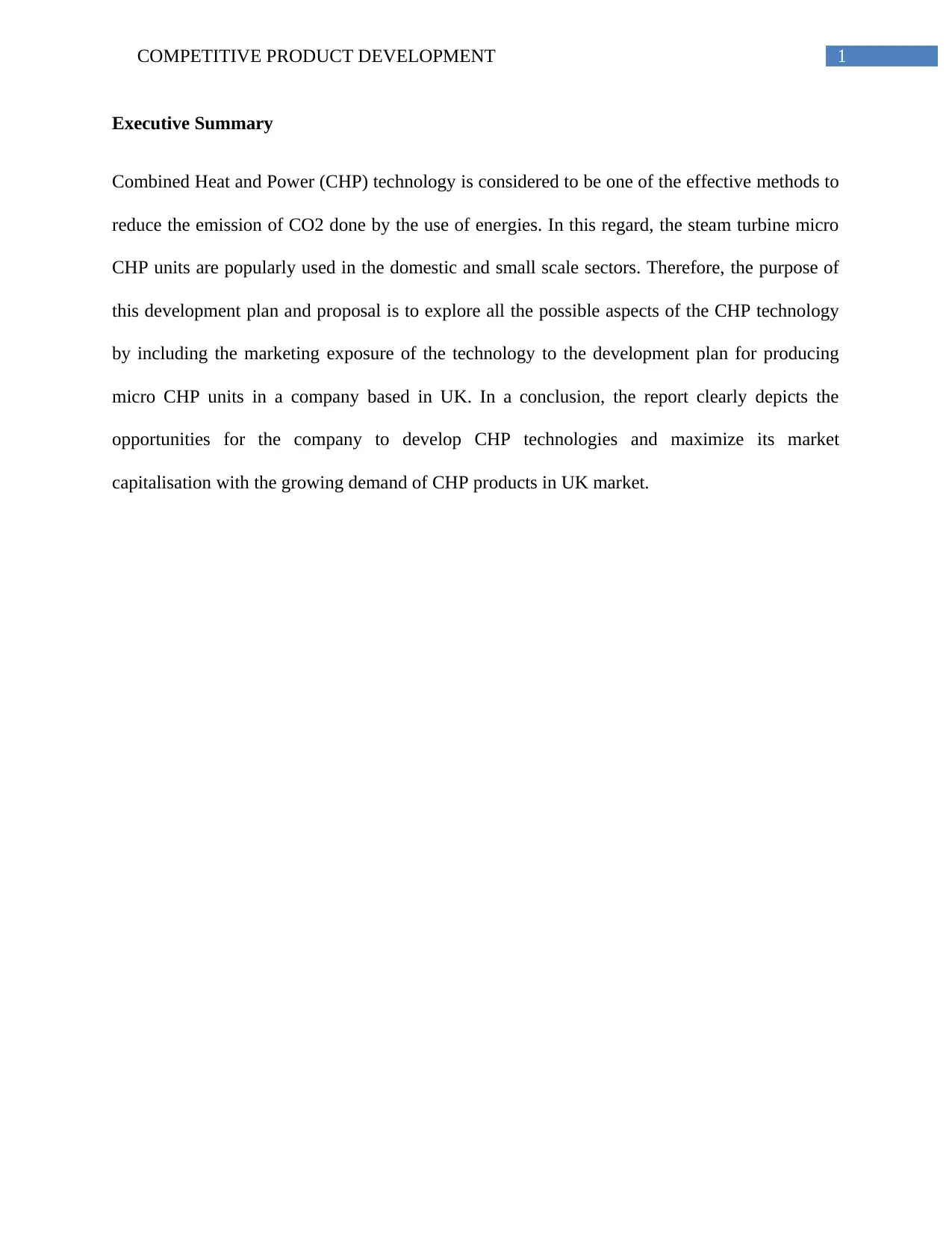
1COMPETITIVE PRODUCT DEVELOPMENT
Executive Summary
Combined Heat and Power (CHP) technology is considered to be one of the effective methods to
reduce the emission of CO2 done by the use of energies. In this regard, the steam turbine micro
CHP units are popularly used in the domestic and small scale sectors. Therefore, the purpose of
this development plan and proposal is to explore all the possible aspects of the CHP technology
by including the marketing exposure of the technology to the development plan for producing
micro CHP units in a company based in UK. In a conclusion, the report clearly depicts the
opportunities for the company to develop CHP technologies and maximize its market
capitalisation with the growing demand of CHP products in UK market.
Executive Summary
Combined Heat and Power (CHP) technology is considered to be one of the effective methods to
reduce the emission of CO2 done by the use of energies. In this regard, the steam turbine micro
CHP units are popularly used in the domestic and small scale sectors. Therefore, the purpose of
this development plan and proposal is to explore all the possible aspects of the CHP technology
by including the marketing exposure of the technology to the development plan for producing
micro CHP units in a company based in UK. In a conclusion, the report clearly depicts the
opportunities for the company to develop CHP technologies and maximize its market
capitalisation with the growing demand of CHP products in UK market.
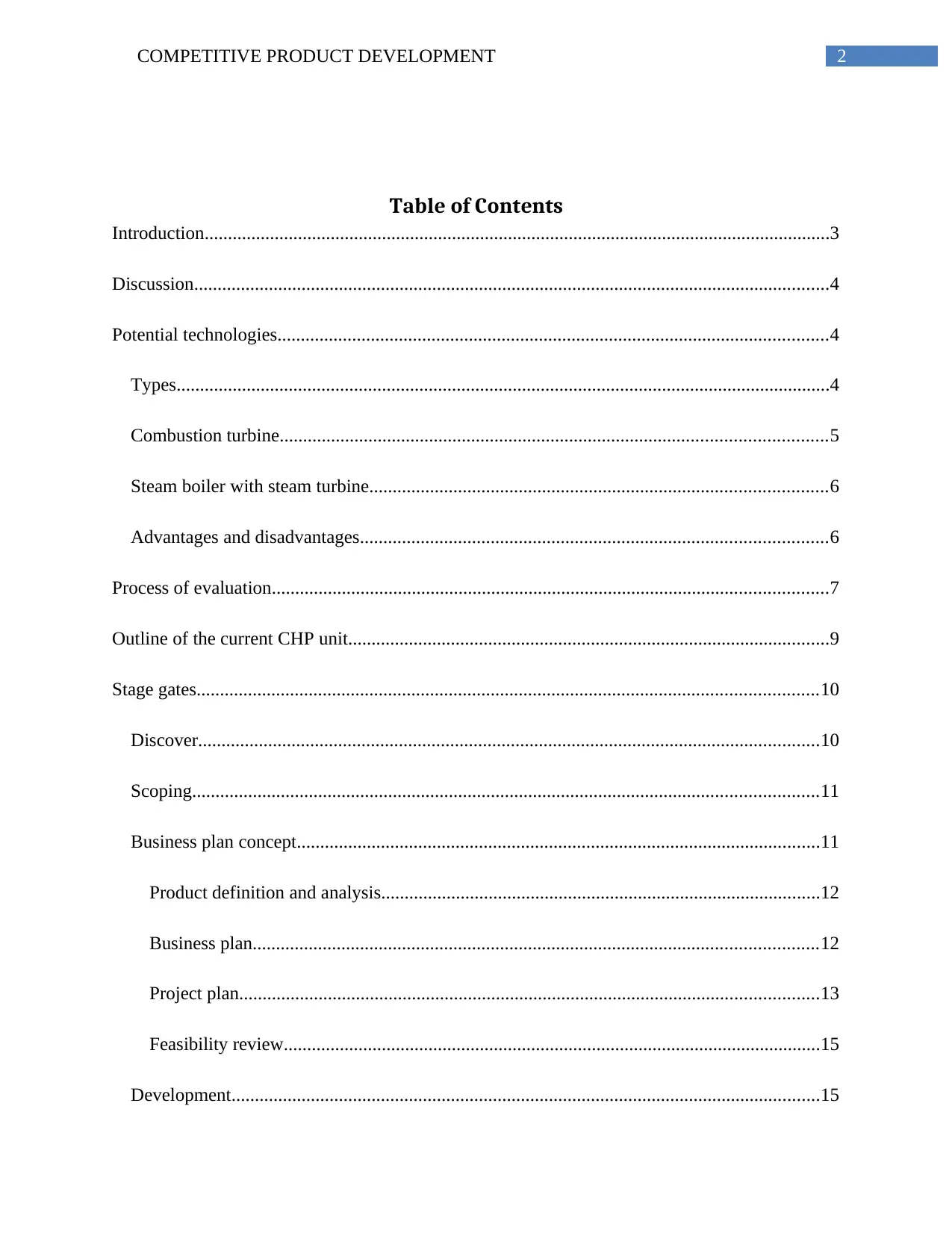
2COMPETITIVE PRODUCT DEVELOPMENT
Table of Contents
Introduction......................................................................................................................................3
Discussion........................................................................................................................................4
Potential technologies......................................................................................................................4
Types............................................................................................................................................4
Combustion turbine.....................................................................................................................5
Steam boiler with steam turbine..................................................................................................6
Advantages and disadvantages....................................................................................................6
Process of evaluation.......................................................................................................................7
Outline of the current CHP unit.......................................................................................................9
Stage gates.....................................................................................................................................10
Discover.....................................................................................................................................10
Scoping......................................................................................................................................11
Business plan concept................................................................................................................11
Product definition and analysis..............................................................................................12
Business plan.........................................................................................................................12
Project plan............................................................................................................................13
Feasibility review...................................................................................................................15
Development..............................................................................................................................15
Table of Contents
Introduction......................................................................................................................................3
Discussion........................................................................................................................................4
Potential technologies......................................................................................................................4
Types............................................................................................................................................4
Combustion turbine.....................................................................................................................5
Steam boiler with steam turbine..................................................................................................6
Advantages and disadvantages....................................................................................................6
Process of evaluation.......................................................................................................................7
Outline of the current CHP unit.......................................................................................................9
Stage gates.....................................................................................................................................10
Discover.....................................................................................................................................10
Scoping......................................................................................................................................11
Business plan concept................................................................................................................11
Product definition and analysis..............................................................................................12
Business plan.........................................................................................................................12
Project plan............................................................................................................................13
Feasibility review...................................................................................................................15
Development..............................................................................................................................15
⊘ This is a preview!⊘
Do you want full access?
Subscribe today to unlock all pages.

Trusted by 1+ million students worldwide
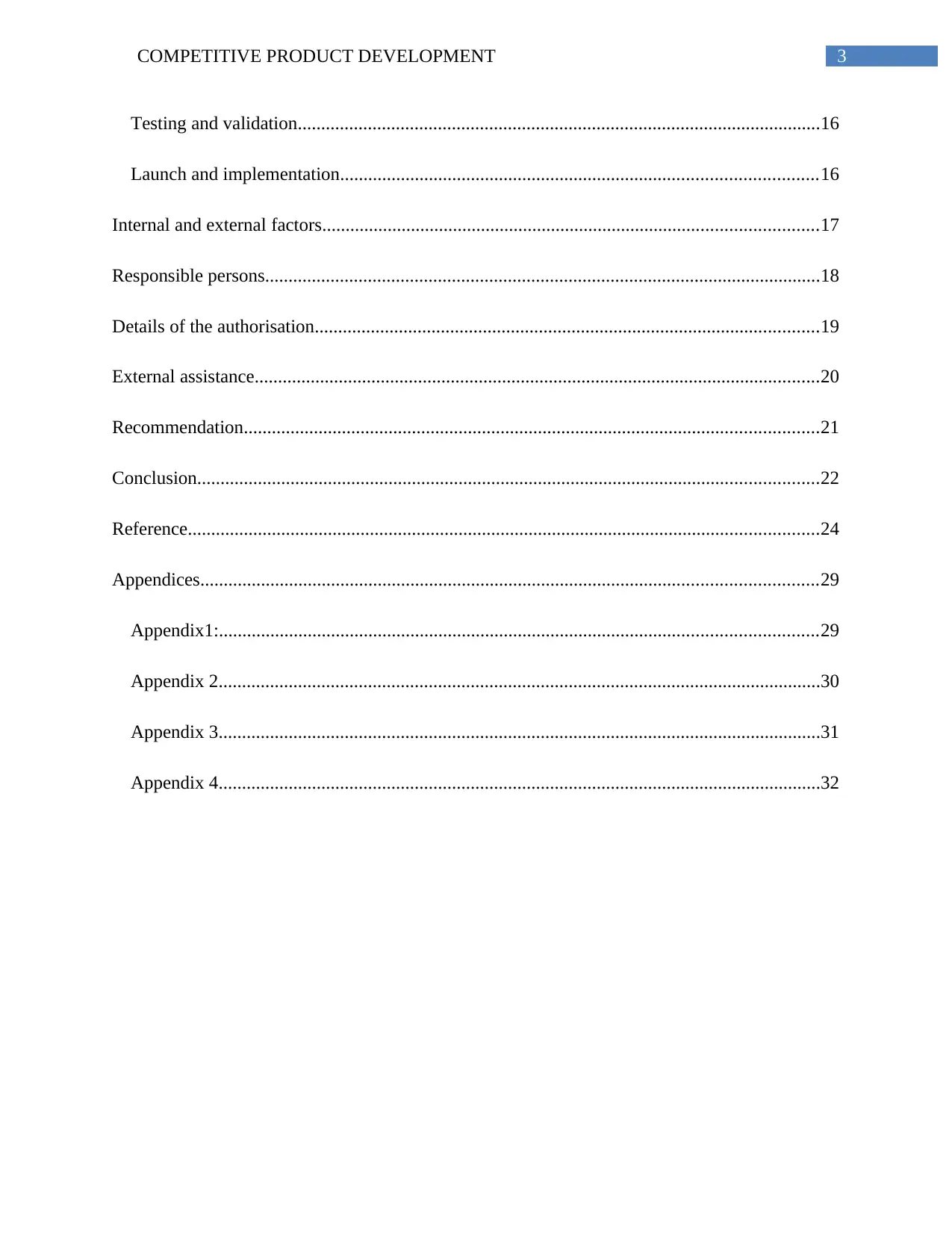
3COMPETITIVE PRODUCT DEVELOPMENT
Testing and validation................................................................................................................16
Launch and implementation......................................................................................................16
Internal and external factors..........................................................................................................17
Responsible persons.......................................................................................................................18
Details of the authorisation............................................................................................................19
External assistance.........................................................................................................................20
Recommendation...........................................................................................................................21
Conclusion.....................................................................................................................................22
Reference.......................................................................................................................................24
Appendices....................................................................................................................................29
Appendix1:................................................................................................................................29
Appendix 2.................................................................................................................................30
Appendix 3.................................................................................................................................31
Appendix 4.................................................................................................................................32
Testing and validation................................................................................................................16
Launch and implementation......................................................................................................16
Internal and external factors..........................................................................................................17
Responsible persons.......................................................................................................................18
Details of the authorisation............................................................................................................19
External assistance.........................................................................................................................20
Recommendation...........................................................................................................................21
Conclusion.....................................................................................................................................22
Reference.......................................................................................................................................24
Appendices....................................................................................................................................29
Appendix1:................................................................................................................................29
Appendix 2.................................................................................................................................30
Appendix 3.................................................................................................................................31
Appendix 4.................................................................................................................................32
Paraphrase This Document
Need a fresh take? Get an instant paraphrase of this document with our AI Paraphraser
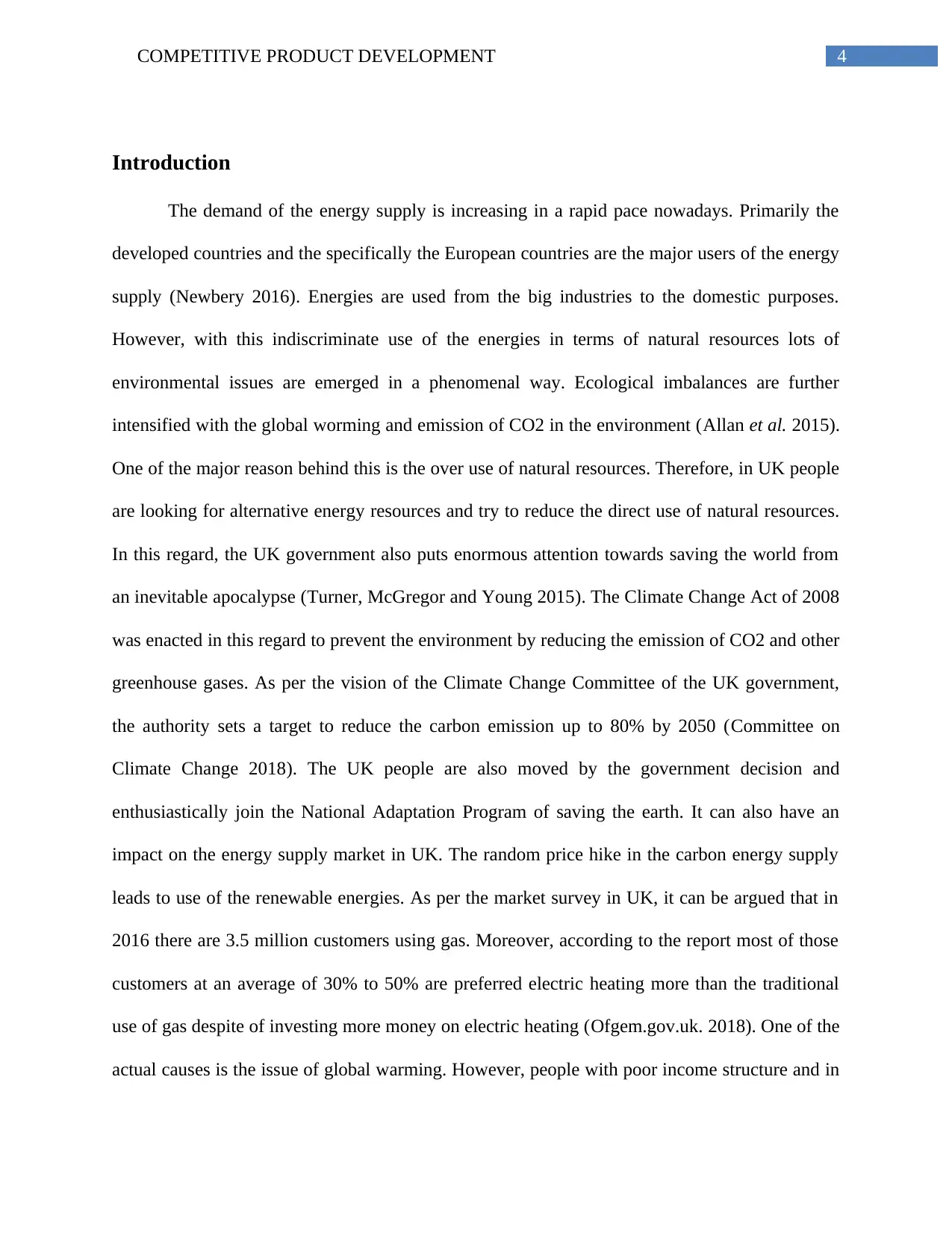
4COMPETITIVE PRODUCT DEVELOPMENT
Introduction
The demand of the energy supply is increasing in a rapid pace nowadays. Primarily the
developed countries and the specifically the European countries are the major users of the energy
supply (Newbery 2016). Energies are used from the big industries to the domestic purposes.
However, with this indiscriminate use of the energies in terms of natural resources lots of
environmental issues are emerged in a phenomenal way. Ecological imbalances are further
intensified with the global worming and emission of CO2 in the environment (Allan et al. 2015).
One of the major reason behind this is the over use of natural resources. Therefore, in UK people
are looking for alternative energy resources and try to reduce the direct use of natural resources.
In this regard, the UK government also puts enormous attention towards saving the world from
an inevitable apocalypse (Turner, McGregor and Young 2015). The Climate Change Act of 2008
was enacted in this regard to prevent the environment by reducing the emission of CO2 and other
greenhouse gases. As per the vision of the Climate Change Committee of the UK government,
the authority sets a target to reduce the carbon emission up to 80% by 2050 (Committee on
Climate Change 2018). The UK people are also moved by the government decision and
enthusiastically join the National Adaptation Program of saving the earth. It can also have an
impact on the energy supply market in UK. The random price hike in the carbon energy supply
leads to use of the renewable energies. As per the market survey in UK, it can be argued that in
2016 there are 3.5 million customers using gas. Moreover, according to the report most of those
customers at an average of 30% to 50% are preferred electric heating more than the traditional
use of gas despite of investing more money on electric heating (Ofgem.gov.uk. 2018). One of the
actual causes is the issue of global warming. However, people with poor income structure and in
Introduction
The demand of the energy supply is increasing in a rapid pace nowadays. Primarily the
developed countries and the specifically the European countries are the major users of the energy
supply (Newbery 2016). Energies are used from the big industries to the domestic purposes.
However, with this indiscriminate use of the energies in terms of natural resources lots of
environmental issues are emerged in a phenomenal way. Ecological imbalances are further
intensified with the global worming and emission of CO2 in the environment (Allan et al. 2015).
One of the major reason behind this is the over use of natural resources. Therefore, in UK people
are looking for alternative energy resources and try to reduce the direct use of natural resources.
In this regard, the UK government also puts enormous attention towards saving the world from
an inevitable apocalypse (Turner, McGregor and Young 2015). The Climate Change Act of 2008
was enacted in this regard to prevent the environment by reducing the emission of CO2 and other
greenhouse gases. As per the vision of the Climate Change Committee of the UK government,
the authority sets a target to reduce the carbon emission up to 80% by 2050 (Committee on
Climate Change 2018). The UK people are also moved by the government decision and
enthusiastically join the National Adaptation Program of saving the earth. It can also have an
impact on the energy supply market in UK. The random price hike in the carbon energy supply
leads to use of the renewable energies. As per the market survey in UK, it can be argued that in
2016 there are 3.5 million customers using gas. Moreover, according to the report most of those
customers at an average of 30% to 50% are preferred electric heating more than the traditional
use of gas despite of investing more money on electric heating (Ofgem.gov.uk. 2018). One of the
actual causes is the issue of global warming. However, people with poor income structure and in
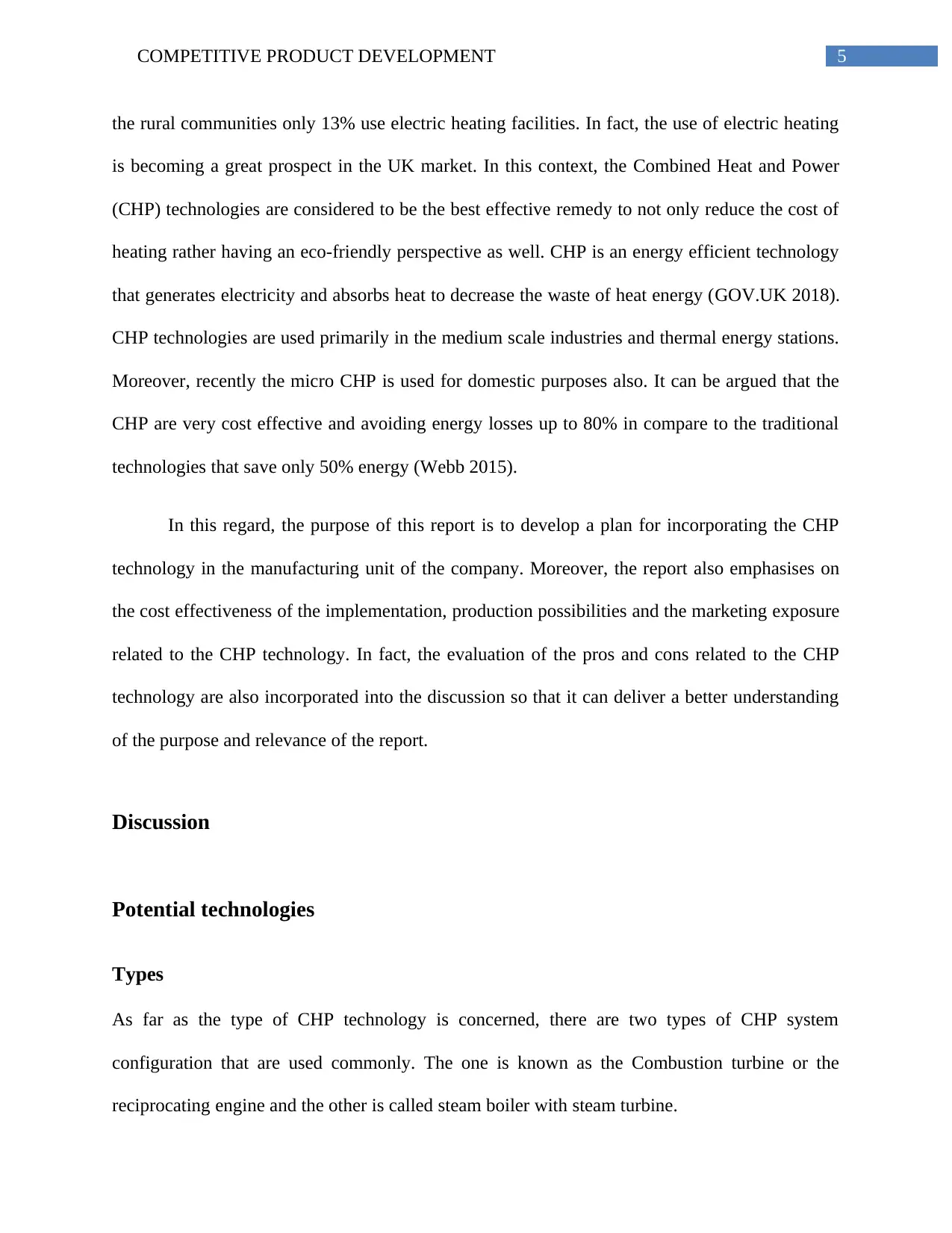
5COMPETITIVE PRODUCT DEVELOPMENT
the rural communities only 13% use electric heating facilities. In fact, the use of electric heating
is becoming a great prospect in the UK market. In this context, the Combined Heat and Power
(CHP) technologies are considered to be the best effective remedy to not only reduce the cost of
heating rather having an eco-friendly perspective as well. CHP is an energy efficient technology
that generates electricity and absorbs heat to decrease the waste of heat energy (GOV.UK 2018).
CHP technologies are used primarily in the medium scale industries and thermal energy stations.
Moreover, recently the micro CHP is used for domestic purposes also. It can be argued that the
CHP are very cost effective and avoiding energy losses up to 80% in compare to the traditional
technologies that save only 50% energy (Webb 2015).
In this regard, the purpose of this report is to develop a plan for incorporating the CHP
technology in the manufacturing unit of the company. Moreover, the report also emphasises on
the cost effectiveness of the implementation, production possibilities and the marketing exposure
related to the CHP technology. In fact, the evaluation of the pros and cons related to the CHP
technology are also incorporated into the discussion so that it can deliver a better understanding
of the purpose and relevance of the report.
Discussion
Potential technologies
Types
As far as the type of CHP technology is concerned, there are two types of CHP system
configuration that are used commonly. The one is known as the Combustion turbine or the
reciprocating engine and the other is called steam boiler with steam turbine.
the rural communities only 13% use electric heating facilities. In fact, the use of electric heating
is becoming a great prospect in the UK market. In this context, the Combined Heat and Power
(CHP) technologies are considered to be the best effective remedy to not only reduce the cost of
heating rather having an eco-friendly perspective as well. CHP is an energy efficient technology
that generates electricity and absorbs heat to decrease the waste of heat energy (GOV.UK 2018).
CHP technologies are used primarily in the medium scale industries and thermal energy stations.
Moreover, recently the micro CHP is used for domestic purposes also. It can be argued that the
CHP are very cost effective and avoiding energy losses up to 80% in compare to the traditional
technologies that save only 50% energy (Webb 2015).
In this regard, the purpose of this report is to develop a plan for incorporating the CHP
technology in the manufacturing unit of the company. Moreover, the report also emphasises on
the cost effectiveness of the implementation, production possibilities and the marketing exposure
related to the CHP technology. In fact, the evaluation of the pros and cons related to the CHP
technology are also incorporated into the discussion so that it can deliver a better understanding
of the purpose and relevance of the report.
Discussion
Potential technologies
Types
As far as the type of CHP technology is concerned, there are two types of CHP system
configuration that are used commonly. The one is known as the Combustion turbine or the
reciprocating engine and the other is called steam boiler with steam turbine.
⊘ This is a preview!⊘
Do you want full access?
Subscribe today to unlock all pages.

Trusted by 1+ million students worldwide

6COMPETITIVE PRODUCT DEVELOPMENT
Combustion turbine
Figure 1: Combustion turbine technology
(Fubara, Cecelja and Yang 2014)
The combustion turbine is associated with a gas or liquid fuel that is combusted in a
prime mover (Fubara, Cecelja and Yang 2014). For the prime mover, the technology can use a
gas turbine or reciprocating engine. There is a generator that is entitled to generate electricity and
the prime mover will be connected with the generator. The combustion engine burns fuel such as
natural gas, oil or biogas and use heat recovery to absorb heat ignited by the engine (Hannon and
Bolton 2015). As a result of that the heat is able to transform into useful energy generally in the
form of steam or heat water. In this respect, this technology is generally used in the thermal
energy stations.
Combustion turbine
Figure 1: Combustion turbine technology
(Fubara, Cecelja and Yang 2014)
The combustion turbine is associated with a gas or liquid fuel that is combusted in a
prime mover (Fubara, Cecelja and Yang 2014). For the prime mover, the technology can use a
gas turbine or reciprocating engine. There is a generator that is entitled to generate electricity and
the prime mover will be connected with the generator. The combustion engine burns fuel such as
natural gas, oil or biogas and use heat recovery to absorb heat ignited by the engine (Hannon and
Bolton 2015). As a result of that the heat is able to transform into useful energy generally in the
form of steam or heat water. In this respect, this technology is generally used in the thermal
energy stations.
Paraphrase This Document
Need a fresh take? Get an instant paraphrase of this document with our AI Paraphraser
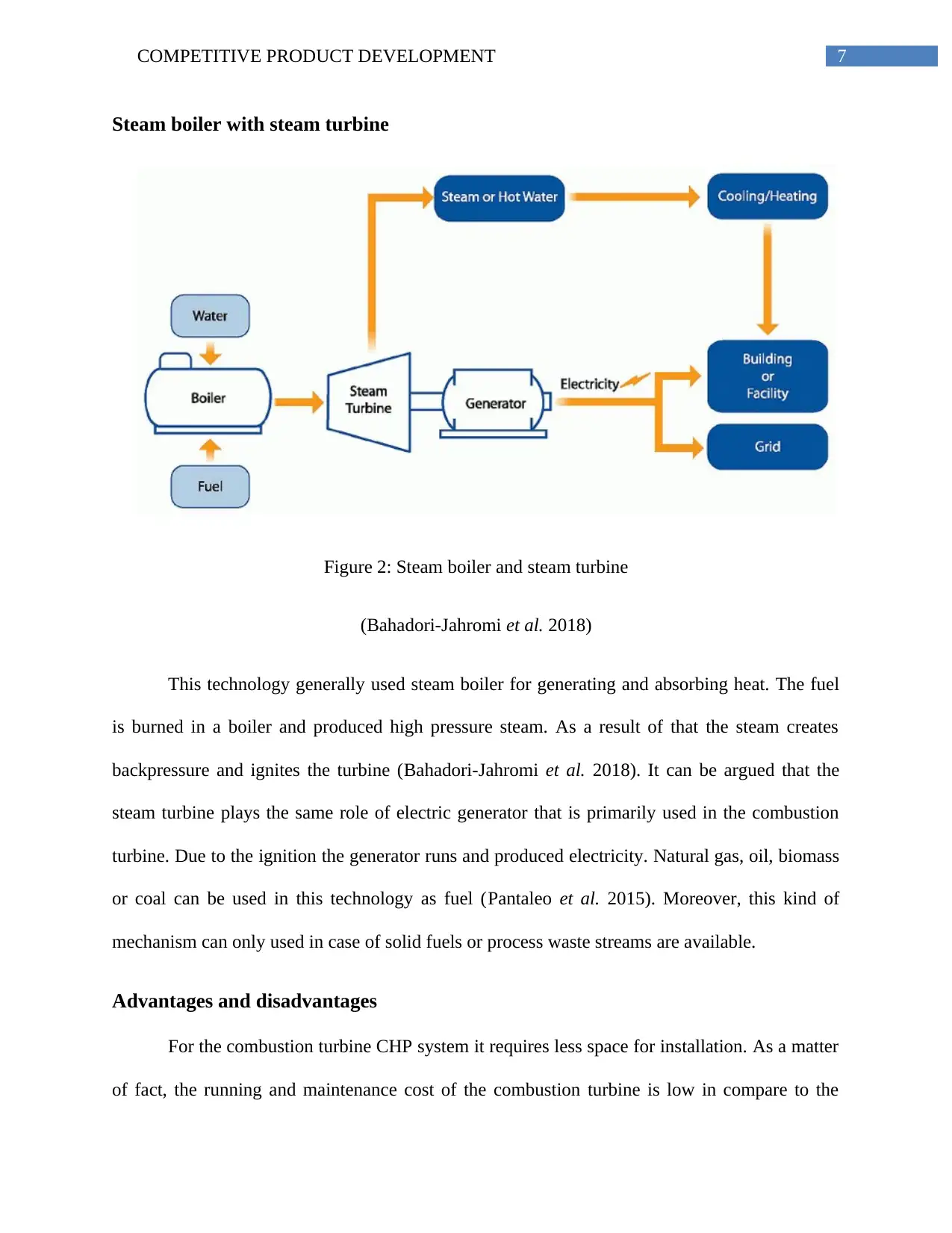
7COMPETITIVE PRODUCT DEVELOPMENT
Steam boiler with steam turbine
Figure 2: Steam boiler and steam turbine
(Bahadori-Jahromi et al. 2018)
This technology generally used steam boiler for generating and absorbing heat. The fuel
is burned in a boiler and produced high pressure steam. As a result of that the steam creates
backpressure and ignites the turbine (Bahadori-Jahromi et al. 2018). It can be argued that the
steam turbine plays the same role of electric generator that is primarily used in the combustion
turbine. Due to the ignition the generator runs and produced electricity. Natural gas, oil, biomass
or coal can be used in this technology as fuel (Pantaleo et al. 2015). Moreover, this kind of
mechanism can only used in case of solid fuels or process waste streams are available.
Advantages and disadvantages
For the combustion turbine CHP system it requires less space for installation. As a matter
of fact, the running and maintenance cost of the combustion turbine is low in compare to the
Steam boiler with steam turbine
Figure 2: Steam boiler and steam turbine
(Bahadori-Jahromi et al. 2018)
This technology generally used steam boiler for generating and absorbing heat. The fuel
is burned in a boiler and produced high pressure steam. As a result of that the steam creates
backpressure and ignites the turbine (Bahadori-Jahromi et al. 2018). It can be argued that the
steam turbine plays the same role of electric generator that is primarily used in the combustion
turbine. Due to the ignition the generator runs and produced electricity. Natural gas, oil, biomass
or coal can be used in this technology as fuel (Pantaleo et al. 2015). Moreover, this kind of
mechanism can only used in case of solid fuels or process waste streams are available.
Advantages and disadvantages
For the combustion turbine CHP system it requires less space for installation. As a matter
of fact, the running and maintenance cost of the combustion turbine is low in compare to the
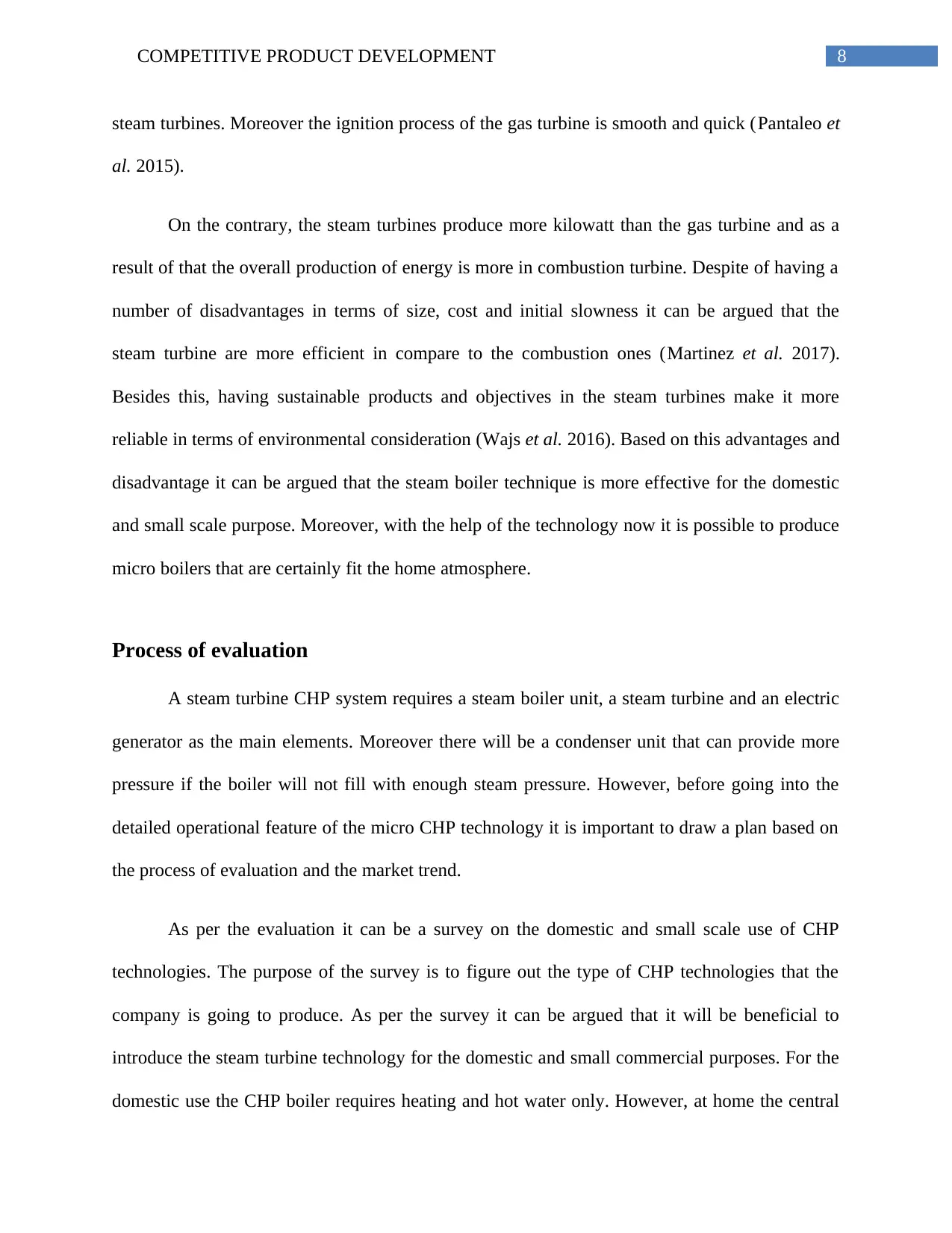
8COMPETITIVE PRODUCT DEVELOPMENT
steam turbines. Moreover the ignition process of the gas turbine is smooth and quick (Pantaleo et
al. 2015).
On the contrary, the steam turbines produce more kilowatt than the gas turbine and as a
result of that the overall production of energy is more in combustion turbine. Despite of having a
number of disadvantages in terms of size, cost and initial slowness it can be argued that the
steam turbine are more efficient in compare to the combustion ones (Martinez et al. 2017).
Besides this, having sustainable products and objectives in the steam turbines make it more
reliable in terms of environmental consideration (Wajs et al. 2016). Based on this advantages and
disadvantage it can be argued that the steam boiler technique is more effective for the domestic
and small scale purpose. Moreover, with the help of the technology now it is possible to produce
micro boilers that are certainly fit the home atmosphere.
Process of evaluation
A steam turbine CHP system requires a steam boiler unit, a steam turbine and an electric
generator as the main elements. Moreover there will be a condenser unit that can provide more
pressure if the boiler will not fill with enough steam pressure. However, before going into the
detailed operational feature of the micro CHP technology it is important to draw a plan based on
the process of evaluation and the market trend.
As per the evaluation it can be a survey on the domestic and small scale use of CHP
technologies. The purpose of the survey is to figure out the type of CHP technologies that the
company is going to produce. As per the survey it can be argued that it will be beneficial to
introduce the steam turbine technology for the domestic and small commercial purposes. For the
domestic use the CHP boiler requires heating and hot water only. However, at home the central
steam turbines. Moreover the ignition process of the gas turbine is smooth and quick (Pantaleo et
al. 2015).
On the contrary, the steam turbines produce more kilowatt than the gas turbine and as a
result of that the overall production of energy is more in combustion turbine. Despite of having a
number of disadvantages in terms of size, cost and initial slowness it can be argued that the
steam turbine are more efficient in compare to the combustion ones (Martinez et al. 2017).
Besides this, having sustainable products and objectives in the steam turbines make it more
reliable in terms of environmental consideration (Wajs et al. 2016). Based on this advantages and
disadvantage it can be argued that the steam boiler technique is more effective for the domestic
and small scale purpose. Moreover, with the help of the technology now it is possible to produce
micro boilers that are certainly fit the home atmosphere.
Process of evaluation
A steam turbine CHP system requires a steam boiler unit, a steam turbine and an electric
generator as the main elements. Moreover there will be a condenser unit that can provide more
pressure if the boiler will not fill with enough steam pressure. However, before going into the
detailed operational feature of the micro CHP technology it is important to draw a plan based on
the process of evaluation and the market trend.
As per the evaluation it can be a survey on the domestic and small scale use of CHP
technologies. The purpose of the survey is to figure out the type of CHP technologies that the
company is going to produce. As per the survey it can be argued that it will be beneficial to
introduce the steam turbine technology for the domestic and small commercial purposes. For the
domestic use the CHP boiler requires heating and hot water only. However, at home the central
⊘ This is a preview!⊘
Do you want full access?
Subscribe today to unlock all pages.

Trusted by 1+ million students worldwide

9COMPETITIVE PRODUCT DEVELOPMENT
generation comprises the significant proportion of the energy through heat losses and the
transmission and distribution network. The role of CHP boiler is to reduce the losses and capture
heat (Wajs et al. 2016). As a result of that it creates an efficient energy saving mechanism that is
able to save 25% of the total energy costs for a domestic consumer (Pantaleo, Camporeale and
Fortunato 2015). In addition to this, the emission of CO2 from the domestic uses can also be
decreased up to 1.5 tonnes per annum (GOV.UK. 2018). Therefore, in UK people are looking for
such an efficient energy saving mechanism that not only reduce the carbon emission up to a
significant level but also facilitates a service where the consumer can save energy cost to a great
extent.
From the perspective of the market, in UK the demand of combined heat and power
technology is very high and both the heavy industries and small and medium scale business
sectors are looking for implementing such technology. As far as the global Combined Heat and
Power market is concerned, it can be expected to stretch the capacity up to 972 GW by 2025
(Pantaleo et al. 2015). This is a very promising index regarding manufacturing CHP products in
a large scale. In fact, it is essentially combined with the government regulations and vision to
reduce the greenhouse gas emission to a great extent by 2050. According to Wajs et al. (2016)
there is a high exposure for the CHP boiler technology to be incorporate in the UK hotel
industries because of its cost reduction feature and the eco-friendly approach. However, in the
domestic sector the average electricity consumption has been reduced to a great level of less that
26% by 2016 in compare to the 2006 statistics (Ofgem.gov.uk. 2018). Subsequently, the gas
consumption has also been challenged with a reduction of 20% in 2016.in this context, the
manufacture of CHP can be a strategic measure for the UK companies.
generation comprises the significant proportion of the energy through heat losses and the
transmission and distribution network. The role of CHP boiler is to reduce the losses and capture
heat (Wajs et al. 2016). As a result of that it creates an efficient energy saving mechanism that is
able to save 25% of the total energy costs for a domestic consumer (Pantaleo, Camporeale and
Fortunato 2015). In addition to this, the emission of CO2 from the domestic uses can also be
decreased up to 1.5 tonnes per annum (GOV.UK. 2018). Therefore, in UK people are looking for
such an efficient energy saving mechanism that not only reduce the carbon emission up to a
significant level but also facilitates a service where the consumer can save energy cost to a great
extent.
From the perspective of the market, in UK the demand of combined heat and power
technology is very high and both the heavy industries and small and medium scale business
sectors are looking for implementing such technology. As far as the global Combined Heat and
Power market is concerned, it can be expected to stretch the capacity up to 972 GW by 2025
(Pantaleo et al. 2015). This is a very promising index regarding manufacturing CHP products in
a large scale. In fact, it is essentially combined with the government regulations and vision to
reduce the greenhouse gas emission to a great extent by 2050. According to Wajs et al. (2016)
there is a high exposure for the CHP boiler technology to be incorporate in the UK hotel
industries because of its cost reduction feature and the eco-friendly approach. However, in the
domestic sector the average electricity consumption has been reduced to a great level of less that
26% by 2016 in compare to the 2006 statistics (Ofgem.gov.uk. 2018). Subsequently, the gas
consumption has also been challenged with a reduction of 20% in 2016.in this context, the
manufacture of CHP can be a strategic measure for the UK companies.
Paraphrase This Document
Need a fresh take? Get an instant paraphrase of this document with our AI Paraphraser

10COMPETITIVE PRODUCT DEVELOPMENT
Outline of the current CHP unit
This section is going to discuss the prototype of domestic CHP technology. The micro
CHP model requires a gas boiler, an oil circulation pump, oil flow meter, ball valve, evaporator,
manometer, safety valve, compensation vessel, mass flow meter, pump of the working fluid,
throttle valve, expander, alternator, condenser, water flow meter.
In this regard, the domestic gas boiler is entitled to transfer the chemical energy into
steams that are coupled with the oil. As a matter of fact, the oil plays the role of a catalyst in
terms of the intermediate heat transfer medium circulating into the boiler and the evaporator of
the vapour cycle (Pantaleo et al. 2015). In addition to this, the role of the circulation pump is to
enhance the oil circulation with a maximum capacity. In addition to this, there is also a vane flow
meter that is entrusted with the role to measure the volumetric flow of the oil. The circulation of
ethyl alcohol or the H2O in a closed loop model is generated by a gear pump with magnetic
coupling of a nominal capacity and a differential pressure. In fact, there is a possibility of
changing the frequency of the pump’s efficiency (Wajs et al. 2016). In this regard, the Coriolis’
force plays a significant role in the signal converter to measure the flow of ethanol or H2O.
After that the saturated or superheated vapour will be directed to the turbine with the
purpose of expansion and then enters into the condenser (Pantaleo, A.M., Camporeale, S. and
Fortunato 2015). As a matter of fact, it can be argued that during the start up phase the turbine is
bypassed by the throttling valve to obtain required vapour parameters. The condenser can be
cooled by water and after the process the condensate was turned back to the reservoir (Martinez
et al. 2017). Therefore, a detailed description of the micro CHP is as follows;
Electrical power output 1.8- 1.9 kW
Outline of the current CHP unit
This section is going to discuss the prototype of domestic CHP technology. The micro
CHP model requires a gas boiler, an oil circulation pump, oil flow meter, ball valve, evaporator,
manometer, safety valve, compensation vessel, mass flow meter, pump of the working fluid,
throttle valve, expander, alternator, condenser, water flow meter.
In this regard, the domestic gas boiler is entitled to transfer the chemical energy into
steams that are coupled with the oil. As a matter of fact, the oil plays the role of a catalyst in
terms of the intermediate heat transfer medium circulating into the boiler and the evaporator of
the vapour cycle (Pantaleo et al. 2015). In addition to this, the role of the circulation pump is to
enhance the oil circulation with a maximum capacity. In addition to this, there is also a vane flow
meter that is entrusted with the role to measure the volumetric flow of the oil. The circulation of
ethyl alcohol or the H2O in a closed loop model is generated by a gear pump with magnetic
coupling of a nominal capacity and a differential pressure. In fact, there is a possibility of
changing the frequency of the pump’s efficiency (Wajs et al. 2016). In this regard, the Coriolis’
force plays a significant role in the signal converter to measure the flow of ethanol or H2O.
After that the saturated or superheated vapour will be directed to the turbine with the
purpose of expansion and then enters into the condenser (Pantaleo, A.M., Camporeale, S. and
Fortunato 2015). As a matter of fact, it can be argued that during the start up phase the turbine is
bypassed by the throttling valve to obtain required vapour parameters. The condenser can be
cooled by water and after the process the condensate was turned back to the reservoir (Martinez
et al. 2017). Therefore, a detailed description of the micro CHP is as follows;
Electrical power output 1.8- 1.9 kW

11COMPETITIVE PRODUCT DEVELOPMENT
Rotational speed of the rotor n ≈36000 rpm
Mass flow rate of ethanol 24 g/s
Vapour pressure at the turbine inlet, 0.7 MPa
The Mach number at the blade cascade output, Ma ≈ 2.4
Stage gates
Discover
It can be argued that the introduction of the CHP technology is an strategic step in regard
to my company. The demand of energy is increasing in a rapid pace in the UK market and
coupled with the environmental issues of emission of CO2 and other green house gases by using
more traditional energies. Henceforth, using renewable energies will be very effective and
strategic for the energy companies. Moreover, as per the UK government act on climate change,
it can be argued that the government also encourages the energy companies to initiate such
measures by producing renewable energy products and technologies that can reduce carbon
emission in the market (Sommer et al. 2015). As a matter of fact, there are demands in the UK
market for renewable and eco-friendly technologies irrespective of the sector.
Therefore, my company is looking for the development of a new heating machine that is
responsible to create heat but reduce the emission of greenhouse gases. In this regard, the micro
combined heat and power technology is the best option to be introduced. However, the company
is restricted in the domestic and small scale industries. As a result of that it will be beneficial if
the company puts emphasis on the steam boiler with steam turbine technology in order to
manufacture a different heating machine.
Rotational speed of the rotor n ≈36000 rpm
Mass flow rate of ethanol 24 g/s
Vapour pressure at the turbine inlet, 0.7 MPa
The Mach number at the blade cascade output, Ma ≈ 2.4
Stage gates
Discover
It can be argued that the introduction of the CHP technology is an strategic step in regard
to my company. The demand of energy is increasing in a rapid pace in the UK market and
coupled with the environmental issues of emission of CO2 and other green house gases by using
more traditional energies. Henceforth, using renewable energies will be very effective and
strategic for the energy companies. Moreover, as per the UK government act on climate change,
it can be argued that the government also encourages the energy companies to initiate such
measures by producing renewable energy products and technologies that can reduce carbon
emission in the market (Sommer et al. 2015). As a matter of fact, there are demands in the UK
market for renewable and eco-friendly technologies irrespective of the sector.
Therefore, my company is looking for the development of a new heating machine that is
responsible to create heat but reduce the emission of greenhouse gases. In this regard, the micro
combined heat and power technology is the best option to be introduced. However, the company
is restricted in the domestic and small scale industries. As a result of that it will be beneficial if
the company puts emphasis on the steam boiler with steam turbine technology in order to
manufacture a different heating machine.
⊘ This is a preview!⊘
Do you want full access?
Subscribe today to unlock all pages.

Trusted by 1+ million students worldwide
1 out of 35
Related Documents
Your All-in-One AI-Powered Toolkit for Academic Success.
+13062052269
info@desklib.com
Available 24*7 on WhatsApp / Email
![[object Object]](/_next/static/media/star-bottom.7253800d.svg)
Unlock your academic potential
Copyright © 2020–2025 A2Z Services. All Rights Reserved. Developed and managed by ZUCOL.




